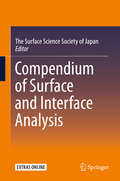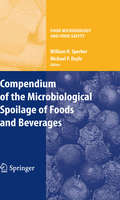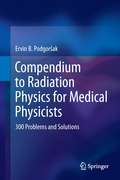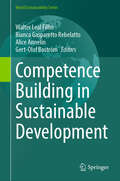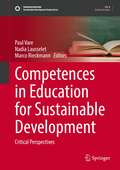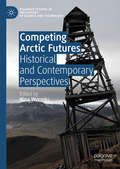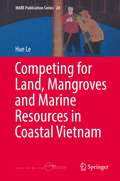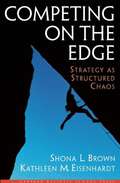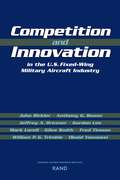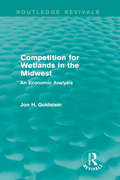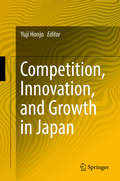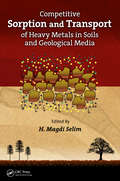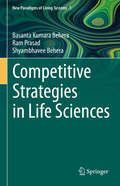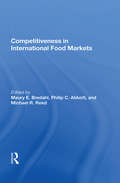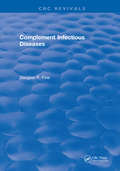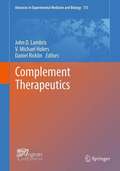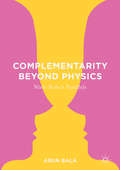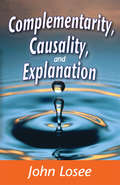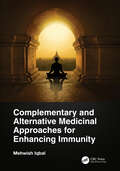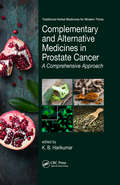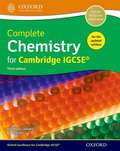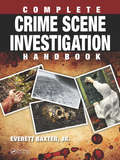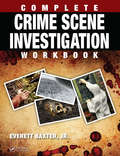- Table View
- List View
Compendium of Phytopathogenic Microbes in Agro-Ecology : Vol.1 Fungi
by Krishna Kumar Natarajan AmaresanThis book offers an in-depth exploration of phytopathogenic fungi within the context of agroecology, providing essential insights for understanding and managing these critical organisms. Each chapter begins with a comprehensive information panel that introduces the pathogen, detailing its taxonomy, the diseases it causes, its pathogenic mechanisms, economic significance, and strategies for identification and control. By equipping researchers with this knowledge, the book empowers them to manipulate these fungi to meet their specific needs. Key concepts covered include the taxonomy and life cycles of various fungi, the economic impact of fungal diseases on crop yield, and innovative control measures. The book's expert contributors provide a thorough analysis of each pathogen, making it an indispensable resource for anyone involved in plant health and disease management. This volume is the first in a three-part series that will cover a total of 104 plant pathogens, including bacteria, viruses, viroids, and nematodes, highlighting their economic importance in agriculture. This book is an invaluable resource for postgraduate students, research scholars, post-doctoral fellows, and educators in fields such as Plant Microbiology, Plant Pathology, Entomology, Virology, and Nematology. It is a must-read for those seeking to deepen their understanding of plant pathogens and their impact on agriculture.
Compendium of Surface and Interface Analysis
by The Surface Science Society of JapanThis book concisely illustrates the techniques of major surface analysis and their applications to a few key examples.Surfaces play crucial roles in various interfacial processes, and their electronic/geometric structures rule the physical/chemical properties. In the last several decades, various techniques for surface analysis have been developed in conjunction with advances in optics, electronics, and quantum beams. This book provides a useful resource for a wide range of scientists and engineers from students to professionals in understanding the main points of each technique, such as principles, capabilities and requirements, at a glance. It is a contemporary encyclopedia for selecting the appropriate method depending on the reader's purpose.
Compendium of the Microbiological Spoilage of Foods and Beverages (Food Microbiology and Food Safety)
by William H. Sperber Michael P. DoyleThough much of our collective knowledge on microbiological spoilage has accrued over the past century and is still valid today, there is no one place to find this information. Compendium of the Microbiological Spoilage of Foods and Beverages is the first book to collect this important information. This book is edited by William H. Sperber and Michael P. Doyle, two of the best researchers in this field.
Compendium to Radiation Physics for Medical Physicists: 300 Problems and Solutions
by Ervin B. PodgorsakThis exercise book contains 500 typical problems and exercises in modern physics and radiation physics with complete solutions, detailed equations and graphs. This textbook is linked directly with the textbook "Radiation Physics for Medical Physicists", Springer (2010) but can also be used in combination with other related textbooks. For ease of use, this textbook has exactly the same organizational layout (14 chapters, 125 sections) as the "Radiation Physics for Medical Physicists" textbook and each section is covered by at least one problem with solution given. Equations, figures and tables are cross-referenced between the two books. It is the only large compilation of textbook material and associated solved problems in medical physics, radiation physics, and biophysics.
Competence Building in Sustainable Development (World Sustainability Series)
by Walter Leal Filho Bianca Gasparetto Rebelatto Alice Annelin Gert-Olof BoströmThis book aims to provide a comprehensive guide to understanding and implementing the competencies required for sustainable development. In recent years, the need for sustainable development has become increasingly evident across various sectors globally. Climate change, resource depletion, and social inequalities pose significant challenges that demand urgent and comprehensive action. The concept of sustainable development is not merely an environmental concern; it encompasses economic, social, and governance dimensions, necessitating a holistic approach to address these interlinked issues effectively. It seeks to bridge the gap between theoretical frameworks and practical applications, offering insights that are relevant to policymakers, educators, business leaders, and individuals committed to sustainability. The genesis of this book lies in the recognition that achieving sustainable development is contingent upon building and enhancing competencies at multiple levels—individual, organizational, and societal. Competence in sustainable development involves a combination of knowledge, skills, attitudes, and values that empower individuals and organizations to contribute effectively to sustainable goals. One of the key strengths of this book is its multidisciplinary approach. Sustainable development is inherently interdisciplinary, requiring insights from environmental science, economics, social sciences, and management studies. The contributors to this book bring diverse perspectives and expertise, ensuring a rich and nuanced exploration of the subject matter. Furthermore, this book emphasizes the importance of education and training in building competencies for sustainable development. It discusses innovative educational approaches, curricula development, and the role of institutions in fostering a culture of sustainability. The role of technology and digital tools in enhancing sustainable practices is also highlighted, recognizing their potential to drive significant positive change.
Competences in Education for Sustainable Development: Critical Perspectives (Sustainable Development Goals Series)
by Paul Vare Marco Rieckmann Nadia LausseletThis volume highlights key moments and movements in this "competence turn" in Education for Sustainable Development (ESD), and explores the different ways in which competences have been conceptualized and implemented. By marshaling a dialogue between chapters and sections, the book provides a coherent whole that will become a key source on ESD competences. The contributors develop a conceptual map against which to chart existing (and future) ESD competence frameworks, offer new critical case studies that explore the implementation of educator competences in ESD at different structural levels in different European contexts, explore the link between pedagogy and educator competence through hitherto unpublished case studies based on current practices across Europe, and consider the impact of the COVID-19 pandemic on ESD and educator competence. The book comprises 23 chapters divided into four sections, with an introduction and concluding chapter. Section One introduces concepts and models related to ESD competences, while the following two sections focus on implementation and pedagogy. In light of the foregoing material, the shorter Section Four is both reflective and forward looking. The primary audience for this book will be academics and students working in the fields of Education, Sustainability Science and related disciplines.
Competing Arctic Futures: Historical and Contemporary Perspectives (Palgrave Studies in the History of Science and Technology)
by Nina WormbsThis edited collection explores how narratives about the future of the Arctic have been produced historically up until the present day. The contemporary deterministic and monolithic narrative is shown to be only one of several possible ways forward. This book problematizes the dominant prediction that there will be increased shipping and resource extraction as the ice melts and shows how this seemingly inevitable future has consequences for the action that can be taken in the present. This collection looks to historical projections about the future of the Arctic, evaluating why some voices have been heard and championed, while others remain marginalised. It questions how these historical perspectives have shaped resource allocation and governance structures to understand the forces behind change in the Arctic region. Considering the history of individuals and institutions, their political and economic networks and their perceived power, the essays in this collection offer new perspectives on how the future of the Arctic has been produced and communicated.
Competing for Land, Mangroves and Marine Resources in Coastal Vietnam (MARE Publication Series #24)
by Hue LeThis book presents a historical and ethnographic study of changing mangrove management in northern Vietnam over the past 100 years, grounded in a case study in the Red River Delta in northern Vietnam. The book shows that three primary socio-economic dynamics have affected mangroves: enclosure movements that have restricted access by different user communities over time, such as the exclusion of women; changing valuation of mangroves and their products and services; and social and class differentiation caused by privatization of once common resources. The result of these pressures have been erosions of norms, rules, and collective action to protect and nurture mangroves, leading to widespread loss of coastal forests. Sustainable mangrove management will require attention to these dynamics to address current-day land conflicts. The book will be of interest to policy-makers, practitioners, and academics and students in forest policy, management and governance; rural livelihoods; and globalization and agrarian change.
Competing on the Edge: Strategy as Structured Chaos
by Shona L. Brown Kathleen M. EisenhardtCompeting on the edge is an unpredictable, uncontrollable, often even inefficient strategy, yet a singularly effective one in an era driven by change. By linking the practical concerns of business managers to some of the most exciting ideas from science concerning complexity and evolution, the authors have created a bold new strategy that harnesses the dynamic nature of change to create a continuous flow of competitive advantages.
Competing with the Soviets: Science, Technology, and the State in Cold War America (Johns Hopkins Introductory Studies in the History of Science)
by Audra J. WolfeA synthetic account of how science became a central weapon in the ideological Cold War.Honorable Mention for the Forum for the History of Science in America Book Prize of the Forum for the History of Science in AmericaFor most of the second half of the twentieth century, the United States and its allies competed with a hostile Soviet Union in almost every way imaginable except open military engagement. The Cold War placed two opposite conceptions of the good society before the uncommitted world and history itself, and science figured prominently in the picture. Competing with the Soviets offers a short, accessible introduction to the special role that science and technology played in maintaining state power during the Cold War, from the atomic bomb to the Human Genome Project.The high-tech machinery of nuclear physics and the space race are at the center of this story, but Audra J. Wolfe also examines the surrogate battlefield of scientific achievement in such diverse fields as urban planning, biology, and economics; explains how defense-driven federal investments created vast laboratories and research programs; and shows how unfamiliar worries about national security and corrosive questions of loyalty crept into the supposedly objective scholarly enterprise.Based on the assumption that scientists are participants in the culture in which they live, Competing with the Soviets looks beyond the debate about whether military influence distorted science in the Cold War. Scientists’ choices and opportunities have always been shaped by the ideological assumptions, political mandates, and social mores of their times. The idea that American science ever operated in a free zone outside of politics is, Wolfe argues, itself a legacy of the ideological Cold War that held up American science, and scientists, as beacons of freedom in contrast to their peers in the Soviet Union. Arranged chronologically and thematically, the book highlights how ideas about the appropriate relationships among science, scientists, and the state changed over time.
Competition and Innovation in the U.S. Fixed-Wing Military Aircraft Industry
by Mark A. Lorell Gordon T. Lee Jeffrey A. Drezner John Birkler Anthony G. BowerAssess prospects for innovation and competition in the military combat-aircraft industry.
Competition for Wetlands in the Midwest: An Economic Analysis (Routledge Revivals)
by Jon H. GoldsteinIn the Midwest, wetlands can be seen as a nuisance to farmers as they can severely increase production costs. Wetlands are however are a major part of ecology for migratory waterfowl and drainage of these wetlands could have dire consequences on the population of waterfowl as well as other wildlife. Originally published in 1971, this report attempts to break down the economic factors of competition for wetlands in Minnesota and surrounding areas in a policy-relevant way and to suggest new policy alternatives. This title will be of interest to students of Environmental Studies.
Competition, Innovation, and Growth in Japan
by Yuji HonjoThis book addresses three important concepts in the economy--competition, innovation, and growth--using various cases and available data in Japan and other countries. First, the authors discuss competition, including global competition, to provide a better understanding of competition policy in Japan. Then, the authors examine the effects of human capital and alliance on innovation while providing new innovation indicators. Moreover, the authors examine growth from the perspective of corporate strategy such as acquisition, including international comparison. The interplay of competition, innovation, and growth has been prevalent in Japan, and it still acts as a catalyst for stimulating the stagnant economy. A better understanding of competition, innovation, and growth provides the tools to reinvigorate the stagnant economy in Japan and to reinforce the economy in other countries where the period of rapid growth has ended.
Competitive Sorption and Transport of Heavy Metals in Soils and Geological Media (Emergent Environmental Pollution)
by H. Magdi SelimMost reported incidents of soil contamination include an array of heavy metals species rather than a single ion. The various interactions in these multicomponent or multiple-ion systems significantly impact the fate and transport of heavy metals, and competition for sorption sites on soil matrix surfaces is a common phenomenon. Because of this, con
Competitive Strategies in Life Sciences (New Paradigms of Living Systems #1)
by Basanta Kumara Behera Ram Prasad Shyambhavee BeheraTailoring of biomolecules using protein engineering technology, and host cells culture techniques are among the most sophisticated and elegant achievements of modern applied life sciences in which the basic fundamentals biotechnology are applicable for the development and manufacturing of biologics and other related bio-molecules for a hurdle free life with good health. A majority of biologics derived from genetically modified host cells in the current market are bio-formulation such as antibodies, nucleic acid products and vaccines. Such bio-formulations are developed mainly in two steps i.e. upstream process and downstream process. The first volume of this series begins with the latest information on how the classical stepwise host cells culture (mammals, animals, plants, and bacteria) methodology has been changed to fully continuous or partially continuous host cells culture process in order to economise the biopharmaceutical products manufacturing process. In addition this volume narrates a brief history on conceptual development of new thoughts in designing biotechnology industries for commercial production of variety of therapeutic proteins with structural modification on the basis of clinical requirements. The readers will feel exited by going through the latest discovery and development in applied life sciences for designing innovative biomolecules for health care with utmost safe. The most interesting part of this volume is newly developed concept on bioprinting. It explains how to design and fabricate animate objects by fusing or depositing material of interest in the form of powders, solid dusts, metal, liquid or even living cells or tissues by layers to produce 3D objectives. The first volume ends with the latest information on the current trend in biologics market, market dynamic, drives, and opportunities with challenges.
Competitiveness In International Food Markets
by Maurey E BredahlThe successful completion of the GATT negotiations and the North American Free Trade Agreement and the completion of the EC Internal Market mean that food and agricultural sectors must become internationally competitive. Firms, farm organizations, and governments are seeking to identify strategies and public policies that will increase their compet
Complement Infectious Diseases
by Douglas P. FineThis monograph has been written with the notion that it may be read by complementologists relatively untrained in microbiology and infectious diseases and by microbiologists and infectious diseases specialists relatively untrained in complementology. Thus, abbreviations are used sparingly and jargon has hopefully been minimized. Furthermore, I have attempted to offer general background information where it seemed relevant or helpful.
Complement Therapeutics (Advances in Experimental Medicine and Biology #734)
by John D. Lambris V. Michael Holers Daniel RicklinThis book highlights progress and trends in the rapidly evolving field of complement-related drug discovery and spotlights examples of clinical applications. As an integral part of innate immunity and critical mediator in homeostatic and inflammatory processes, the human complement system has been identified as contributor to a large number of disorders including ocular, cardiovascular, metabolic, autoimmune, and inflammatory diseases as well as in ischemia/reperfusion injury, cancer and sepsis. In addition, complement is often involved in adverse immune reactions to biomaterials, cell and organ transplants or drug delivery systems. Although the complement cascade with its close to 50 extracellular protein targets has long been recognized as an attractive system for therapeutic modulation, the past few years have seen a particularly strong boost in interest. Fueled by novel research insight and the marketing of the first complement-targeted drugs, a plethora of highly creative treatment approaches and potent drug candidates have recently emerged and are currently evaluated in disease models and clinical trials. The chapters in this book cover a wide range of topics related to the development of complement therapeutics, ranging from the molecular and functional description of complement targets to the presentation of novel inhibitors, improved treatment strategies as well as examples of disease models and clinical applications. The broad and up-to-date overview on a highly versatile and dynamic field renders this book an indispensable source of information for researchers and clinicians dealing with therapeutic and disease-related aspects of the human complement system.
Complementarity Beyond Physics: Niels Bohr's Parallels
by Arun BalaIn this study Arun Bala examines the implications that Niels Bohr’s principle of complementarity holds for fields beyond physics. Bohr, one of the founding figures of modern quantum physics, argued that the principle of complementarity he proposed for understanding atomic processes has parallels in psychology, biology, and social science, as well as in Buddhist and Taoist thought. But Bohr failed to offer any explanation for why complementarity might extend beyond physics, and his claims have been widely rejected by scientists as empty speculation. Scientific scepticism has only been reinforced by the naïve enthusiasm of postmodern relativists and New Age intuitionists, who seize upon Bohr’s ideas to justify anti-realist and mystical positions. Arun Bala offers a detailed defence of Bohr’s claim that complementarity has far-reaching implications for the biological and social sciences, as well as for comparative philosophies of science, by explaining Bohr’s parallels as responses to the omnipresence of grown properties in nature.
Complementarity, Causality and Explanation
by John LoseePhilosophers have discussed the relationship of cause and effect from ancient times through our own. Prior to the work of Niels Bohr, these discussions presupposed that successful causal attribution implies explanation. The success of quantum theory challenged this presupposition. Bohr introduced a principle of complementarity that provides a new way of looking at causality and explanation.In this succinct review of the history of these discussions, John Losee presents the philosophical background of debates over the cause-effect relation. He reviews the positions of Aristotle, Rene Descartes, Isaac Newton, David Hume, Immanuel Kant, and John Stuart Mill. He shows how nineteenth-century theories in physics and chemistry were informed by a dominant theory of causality and how specific developments in physics provided the background for the emergence of quantum theory.Problems created for the causality implies explanation thesis by the emergence of quantum theory are reviewed in detail. Losee evaluates Bohr's proposals to apply a principle of complementarity within physics, biology, and psychology. He also discusses the feasibility of using complementarity as a principle of interpretation within Christian theology. This volume, which includes an in-depth index, is an essential addition to the libraries of advanced undergraduate and graduate students, philosophers, and those interested in causality and explanation.
Complementary and Alternative Medicinal Approaches for Enhancing Immunity
by Mehwish IqbalAncient therapeutic systems have played a tremendous role in health preservation all around the globe for thousands of years; even the earliest humans on earth had used these approaches along with simple surgical procedures for the betterment of their health. Complementary and Alternative Medicinal Approaches for Enhancing Immunity examines various aspects of health and diseases and the importance of basic but essential factors for the preservation of health and management of diseases. Concisely written, the author discusses ancient ways to enhance self-healing abilities and stimulate the immune system such as, fasting, meditation, acupuncture, cupping therapy, balneotherapy and aromatherapy. The importance of nutrition and diet is also examined as it plays a crucial role in the prevention and causation of diseases. Additional features include: Discusses how the integration of various CAM modalities helps in enhancing self-healing abilities and boosts the human immune system. Contains various topics from different systems of medicines that are taught widely as individual courses or discussed broadly in several institutes. Reviews Eastern pharmacotherapy and how using certain herbs, minerals, and animal-based products aids in maintaining health and alleviating diseases. Using evidence-based knowledge taken from ancient literature and recently published articles, this book will inform readers on the importance of holistic health approaches and some ancient treatment modalities that enhance the immune system to combat diseases.
Complementary and Alternative Medicines in Prostate Cancer: A Comprehensive Approach (Traditional Herbal Medicines for Modern Times)
by K. B. HarikumarRecent global cancer statistical data has clearly indicated that prostate cancer is currently the second most frequently diagnosed cancer (at 15% of all male cancers) and globally the sixth leading cause of cancer death in males. This book is a summary of prostate cancer, covering its incidence, epidemiology, and current treatment options. It also serves as an up-to-date review of the status of currently available alternative and complementary medicines for treating prostate cancer, including various plant extracts, herbal formulations, natural products, yoga, acupuncture, Ayurveda, homeopathy, and Siddha medicines used in prostate cancer therapy.
Complete Chemistry For Cambridge IGSCE
by Rose Marie Gallagher Paul IngramThe Complete Chemistry for Cambridge IGCSE Student Book's stretching approach is trusted by teachers around the world to support advanced understanding and achievement. With plenty of engaging material, practice questions and practical ideas, this updated edition contains everything your students need to succeed in Cambridge IGCSE Chemistry.
Complete Crime Scene Investigation Handbook
by Everett Baxter Jr.Crime scene investigators are the foundation for every criminal investigation. The admissibility and persuasiveness of evidence in court, and in turn, the success of a case, is largely dependent upon the evidence being properly collected, recorded, and handled for future analysis by investigators and forensic analysts in the lab. Complete Crime Sce
Complete Crime Scene Investigation Workbook
by Everett Baxter Jr.This specially developed workbook can be used in conjunction with the Complete Crime Scene Investigation Handbook (ISBN: 978-1-4987-0144-0) in group training environments, or for individuals looking for independent, step-by-step self-study guide. It presents an abridged version of the Handbook, supplying both students and professionals with the mos

